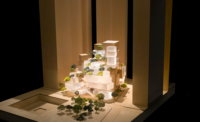By the time Joshua Prince-Ramus was hired to design what is now called the Ronald O. Perelman Performing Arts Center at the World Trade Center, Charcoalblue, a theater design firm with studios in New York and London, had already come up with a layout for the building's three performance venues.
Architects sometimes bristle at overly prescriptive consultants. “We told Joshua he could pull it apart and start over,” said Maggie Boepple, the director of the center. Prince-Ramus reported that he tried to do just that. But eventually, he says, he saw the strengths of the Charcoalblue scheme, and focused on giving it physical form.
Yesterday, Boepple, Prince-Ramus, and businessman Ronald O. Perelman, who made the lead gift toward the $250 million building, presented the result. Prince-Ramus, whose firm, REX, has specialized in high-tech building envelopes, has sheathed the nearly cubic building in a thin layer of marble, which he hopes to obtain from the same quarry that supplied the amber-tinted stone for Cass Gilbert’s Supreme Court building in Washington.
As at the Beinecke Rare Book and Manuscript Library at his alma mater, Yale University, the marble will form thin, translucent sheets (though Prince-Ramus will sandwich his marble sheets between two layers of glass within larger, insulated glass units). As a result, the stone building will be suffused with light by day and will dematerialize at night, like Beinecke and another building cited by Prince-Ramus, Franz Fueg’s Piuskirche in Lucerne.
Inside, the parti is admirably simple: A grand stair, stepping away from the northern of the two memorial fountains, will admit visitors to a lobby level with a restaurant and other amenities. “We will be live all day; you can come for breakfast or a yoga class,” said Boepple.
Upstairs is the “play level,” with the three performance venues, ranging from 99 to 499 seats. Above that is a catwalk level, into which guillotine walls can rise, allowing the venues to merge into each other and into interstitial spaces, offering a large number of possible configurations (One arrangement will accommodate 1,200 visitors). Atop the “play level” is a vast mechanical attic, containing air handling equipment for not just the performing arts center but for the transportation hub below.
The 90,000-square-foot building is expected to open in 2020.
It was old home week at the World Trade Center offices where the building was unveiled. At the preview, Larry Silverstein, the developer of much of the World Trade Center, and Daniel Libeskind, its erstwhile master planner, took their share of credit for the center, which they described as the last piece of the 16-acre puzzle. Architect Michael Arad spoke of pride in seeing his memorial fountains as backdrops for the new building. But the day belonged to Prince-Ramus. That would have been true even if the new board chair of the center, named at Perelman’s suggestion, had appeared. But Barbra Streisand couldn’t make it.
Ground Zero Art Center Design Revealed
Designed by Joshua Prince-Ramus of REX, the Ronald O. Perelman Performing Arts Center will be a marble-clad cube.

Photo © Luxigon

Photo © Luxigon

Photo © DBOX

Photo © Luxigon

Photo © Luxigon

Photo © Luxigon

Photo © Luxigon

Photo © Luxigon

Photo © Luxigon

Photo © Luxigon

Photo © Luxigon

Photo © K18

Photo © REX

Photo © REX

Photo © REX

Photo © Chris Janjic



Post a comment to this article
Report Abusive Comment